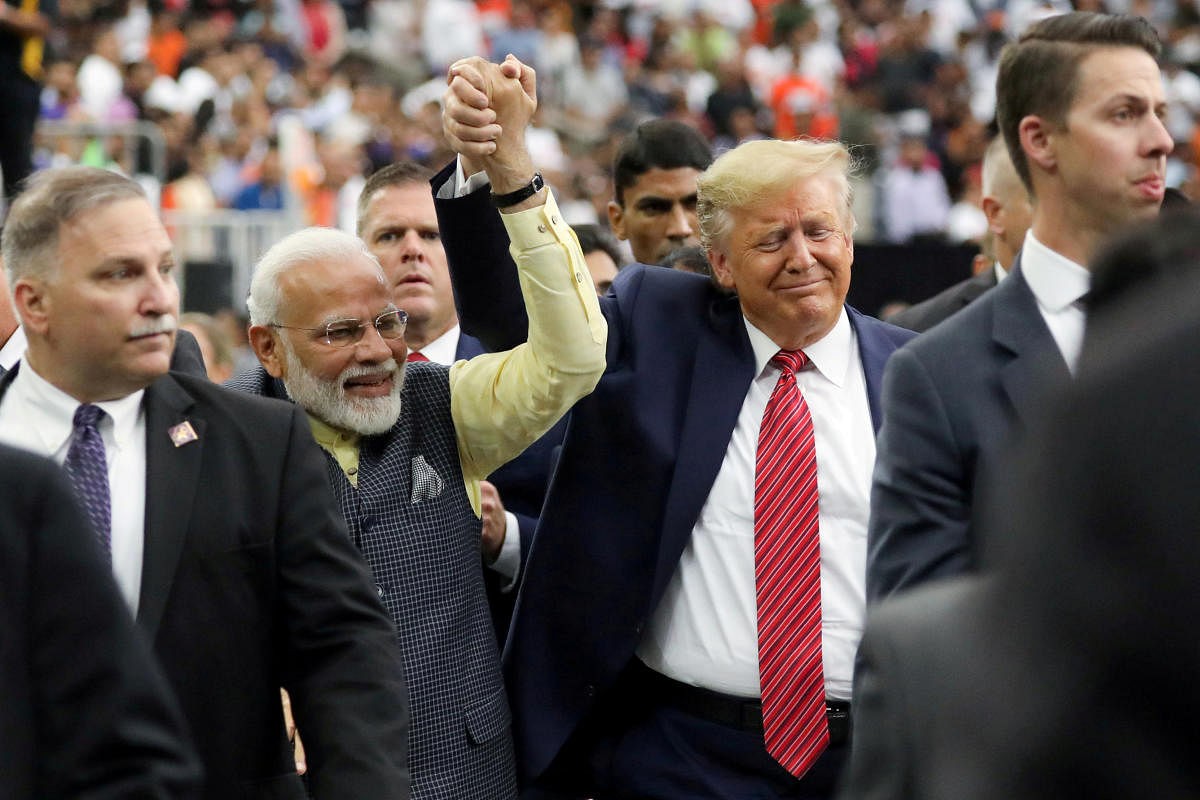
India-US strategic partnership witnessed rapid growth in 2019 with the two sides inking a crucial deal to facilitate the transfer of defense technology and their leaders - President Donald Trump and Prime Minister Narendra Modi - meeting a record four times post-May elections, displaying growing ties between the world's two largest democracies.
The strengthening of the strategic partnership was reflected in the India-US Joint Statement issued at the conclusion of their second 2+2 dialogue towards the end of the year, which was definitely the key highlight of 2019.
The two countries signed a key agreement to facilitate the transfer of defense technology during the second 2+2 meeting in December in Washington, which was attended by their foreign and defense ministers.
For the comfort of Trump, who scans all relationships through the lens of trade, the bilateral trade has increased and in the second half of the year figures started appearing that projected a substantial decline in the bilateral trade deficit in the coming years.
Even though the two countries could not resolve their long-pending trade disputes or a minor trade deal still eludes them, this is no longer an irritation in the bilateral relationship and it is most likely that India's GSP provisions might be restored soon.
In the year gone by, India placed orders worth billions of dollars of state-of-the-art military equipment from the US, started new tri-services exercise 'Tiger Triumph', which will now be an annual affair, signed one more foundational agreement and accelerated the pace of the Defense Technology and Trade Initiative (DTTI).
The co-operation between India and the US has reached a new level when it comes to the Indo-Pacific region. The two countries are working with other like-minded partners in the Indo-Pacific to ensure that there is freedom of navigation and peace in the resource-rich region where China has been trying to spread its influence.
The US is happy that India, though reluctant initially, is now helping giving an institutional shape to Quad - an informal consultative mechanism. Japan and Australia are the other two countries of this grouping.
The US also supported India's stand on the Maldives as New Delhi took the lead to ensure that a third country does not interfere in its internal affairs.
There has been an unprecedented level of cooperation between India and the US on counter-terrorism front this year.
As 40 security personnel were killed in a ghastly terrorist attack in Pulwama in February, the United States was the first country that said that India has the right to self-defend itself.
Even as India was in the middle of its election season, the US went ahead, worked with its partner countries like Britain and France to ensure that China lifts its veto hold from designating Pakistan-based Jaish-e-Mohamad chief Masood Azhar as a global terrorist by the UN Security Council.
While it has expressed strong concerns over human rights issues, religious freedom, internet blackout and detention of political leaders in Kashmir, the Trump Administration has refused to put India at par with some of the non-democratic countries on these issues as was the case in the past.
The Administration says that India being a vibrant democracy with a strong civil society, free press, independent judiciary has enough institutional mechanisms to handle such issues. However, it has made it clear that its eyes are not off the lid and is concerned about some of the recent developments.
Throughout the year, including during the 2+2 dialogue or the 26/11 terror attack anniversary, the US asked Pakistan to take sustained and irreversible actions against terrorist networks operating from its soil.
While the historic 'Howdy, Modi' event – where Trump joined Modi in addressing a huge crowd of 50,000 Indian-Americans – in September was primarily an occasion to showcase people's power of the world's two largest democracies, months later it now appears that a section of the Democrats are having a second thought on the bipartisan support as they believe that post-August 5 when India revoked special status of Jammu and Kashmir, secularism, human rights and freedom of religion in India is being challenged.
For the record, 'Howdy, Modi' event was attended by top Democratic leadership as well. But, no doubt, the proponents of such a view, led by Indian-American Congresswoman Pramila Jayapal and progressive legislatures, do not reflect the view of Democratic Party leadership led by House Speaker Nancy Pelosi, who is a die-hard supporter of India-US relationship.
However, certainly in the months to come, the bitter domestic political divide is likely to widen these initial cracks in this bipartisan support that the India-US relationship has enjoyed over the last two decades, at least since the Clinton Administration and continued through the successive two administrations of presidents George Bush and Barack Obama.
But for this sour note, the India-US strategic relationship progressed at a much faster pace than in any three years of the Trump Administration.
While differences continued to exist on the way forward in Afghanistan, the White House kept New Delhi in the loop on its peace initiatives. Bitter from its past experiences, the Trump Administration did not fall into the trap or rhetoric of Pakistan.
As reflective in its statements, either in the public or before Congressional committees, the Trump Administration has shown a better understating of India's position on Kashmir post-August 5.